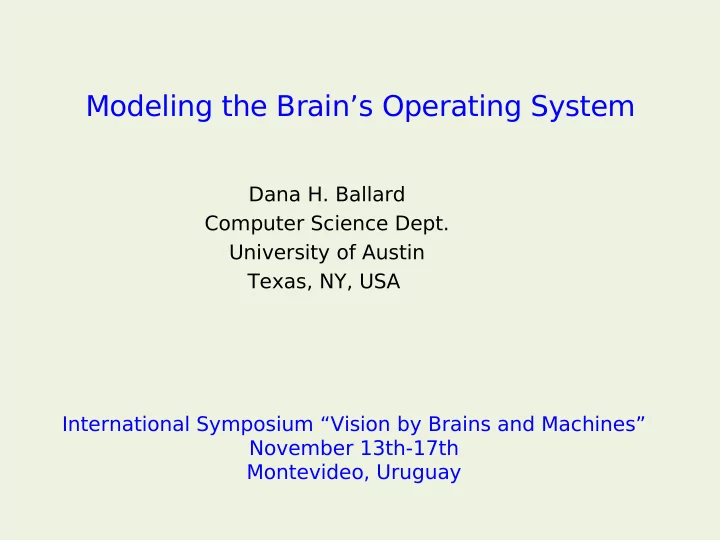

Modeling the Brain’s Operating System Dana H. Ballard Computer Science Dept. University of Austin Texas, NY, USA International Symposium “Vision by Brains and Machines” November 13th-17th Montevideo, Uruguay
Embodied Cognition Brain Body World Maurice Merleau-Ponty 1906- 1961
Timescales 10 3 Memory encoding 10 2 Continuous Activity time sec 10 1 Speed Chess minimum search Sentence generation 10 0 Attention Switching Time Discrete 10 -1 Modal fixation time Shortest Recognition time Round-trip through Cortical Memory 10 -2
QuickTime and a MPEG-4 Video decompressor are needed to see this picture.
Marr = Brooks
Three Levels of a Human “Operating System” Behaviors are scheduled from a pool 3 Behaviors compete Behavior 2 for body’s motor resources 1 Behaviors obtain sensory information
Computational Abstraction Hierarchy Task: Make a PBJ sandwich Component: Remove Jelly Jar Lid Routine: Locate Lid
Multi-tasking As revealed by gaze sharing in human data Mid-Block 40m Stop sign Car Mid-block sign 60 Intersection sign 50 40 Eye 30 20 10 0 0 5 10 15 3 3 3 3 172 10 177 10 182 10 187 10 time(sec) Shinoda and Hayhoe, Vision Research 2001
Visual Routines Roelfsema et al PNAS 2003
Introducing “Walter” QuickTime and aYUV420 codec decompressorare needed to see this picture. Pickup cans Stay on sidewalk Avoid obstacles
Control of visuo-motor routines + only ~4 can run “active” simultaneously + 100-200ms update per behavior “inactive”
Walter’s Visual Routines image Can locations Sidewalk 1-d obstacle locs location
Reinforcement Learning Primer : Before Learning You are here state action
Reinforcement Learning Primer : After Learning γ γ value γ γ γ policy γ γ γ γ
Microbehavior for Litter θ ,d Cleanup 1. Visual 2a. Policy Routine 2b. Value of Policy Q d θ Heading from Walter’s perspective
Learned Microbehaviors Litter Sidewalk Obstacles
Microbehaviors and the body’s resources “active” “inactive” • Gaze direction must use a single best Q value. • Walking direction uses weighted average of Q values.
Which Microbehavior should get the gaze vector? - The best Q The expected Q given given a sample state the state uncertainty
obs side can obs can side
Performance Comparison
Walter crosses the street QuickTime and aYUV420 codec decompressorare needed to see this picture. Pickup cans Stay on sidewalk Avoid obstacles
Running Behaviors: Eye Movement Trace QuickTime and a QuickTime and a decompressor decompressor are needed to see this picture. are needed to see this picture.
Three trials
Eyetracker in V8 helmet QuickTime and aTIFF (Uncompressed) decompressorare needed to see this picture.
Methods Human Ss walk Walter’s route in Virtual Reality. Their 6 dof head Produces position and 2 dof gaze the A curved positions are perception path in real continuously tracked. of a space straight Three subjects were path in used. visual space The resultant video and eye track signal are scored frame-by-frame.
A human walks Walter’s route QuickTime and aYUV420 codec decompressorare needed to see this picture.
Human data: individual fixations Obstacle Litter Sidewalk Corner Crosswalk Otherside
Walter and the humans have similar task prioritie Human subjects(3) Walter(3 trials) 70 120 60 100 50 80 40 60 30 40 20 20 10 0 0 obs side litter Other obs side litter Other
Human data: Two samples with different contexts Obstacle avoidance Near obstacles Litter Crosswalk Approaching Otherside crosswalk Sidewalk Walter
Scheduling Context 14 4.5 25 12 4 3.5 20 10 3 8 15 2.5 2 6 10 1.5 Walter 4 1 5 0.5 2 0 0 0 corner light side crosswalk oherside other corner side obs otherside 25 50 80 45 70 20 40 60 35 15 50 30 Human Ss 40 25 10 20 30 15 20 5 10 10 5 0 0 0 corner light side corner side obs otherside crosswalk otherside other Approaching Waiting for On crosswalk light Crosswalk Walter and the human Ss all exhibit context sensitivities. Human gaze locations are interpreted based on gaze location. The actual internal state is unknown.
Rewards can be changed quickly Litter Sidewalk Obstacles
Changing the reward schedule “ignore the litter” “ignore the obstacles” 60 60 50 50 40 40 Walter 30 30 20 20 10 10 0 0 obs side litter obs side litter 60 60 50 50 40 40 Humans 30 30 20 20 10 10 0 0 obs side litter obs side litter
Match No match 12 Saliency Map 10 vs Gaze 8 courtesy of program 6 provided by 4 Dr. Laurent Itti 2 at the iLab, USC 0 Match No Match
Credit Assignment - MIT model
Credit Assignment - Our Model
The laboratory at Rochester Computer Science Cognitive Science Dana Ballard Mary Hayhoe Brian Sullivan Jelena Jovancevic Constantin Rothkopf Alumni Chen Yu Pili Aivar Nathan Sprague Jochen Triesch Al Robinson Neil Mennie Weilie Yi Jason Droll Xue Gu Jonathan Shaw QuickTime and aTIFF (Uncompressed) decompressorare needed to see this picture. QuickTime and aTIFF (Uncompressed) decompressorare needed to see this picture.
Recommend
More recommend